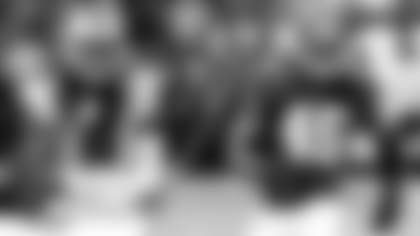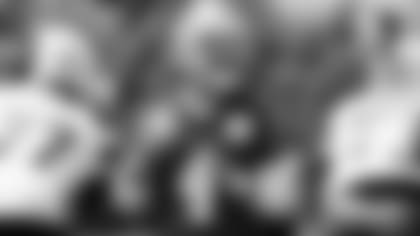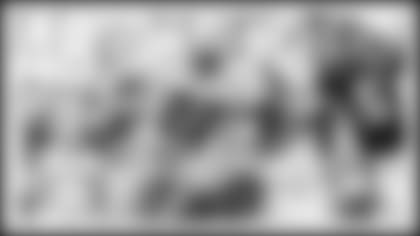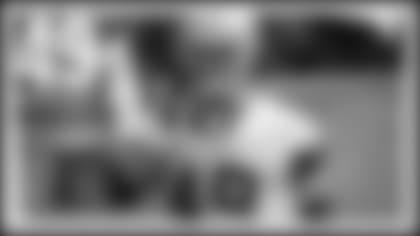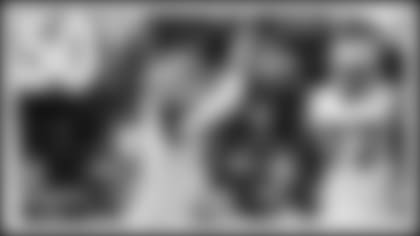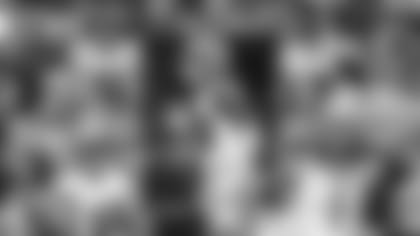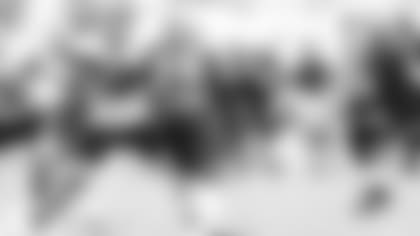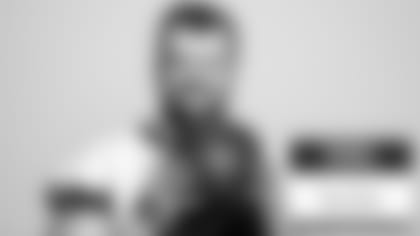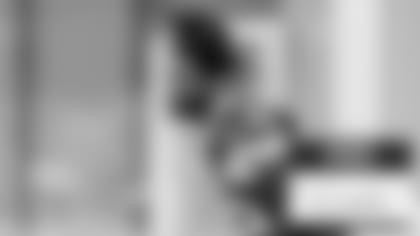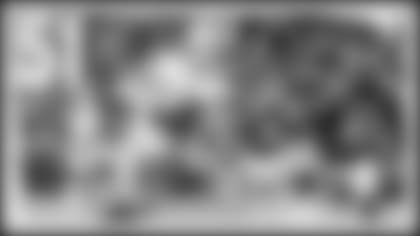FRISCO, Texas – Here is a man of many names.
Began as Larry Rayfield Wright, born Aug. 23, 1945, in tiny Griffin, Ga.
Then just Rayfield.
Eventually "Cat."
Growing into "Big Cat."
Better known as Cowboys offensive tackle.
And to me, after getting to know him much better over the past 22 years, simply "Gentleman."
Rayfield passed away on Thursday at 76 years old. His 13-year NFL career exacted a toll. Serious seizures would finally do him in.
We all know he was belatedly enshrined into the Cowboys' fabled Ring of Honor in 2004. That paving the path into the Pro Football Hall of Fame in 2006, 22 years after he was eligible for his rightful induction.
His résumé includes six Pro Bowl selections. Fellow Hall of Famer Larry Allen (10), Tyron Smith (8) and Zack Martin (7) are the only Cowboys offensive linemen with more.
Rayfield was a four- time All-Pro. A 1970s All-Decade Team member. Winner of two Super Bowls. Played in five. Was a member of Cowboys teams winning five of the six NFC title games played in the 1970s. Only nine players played longer for the Cowboys than Big Cat's 13 seasons. In 1972, was selected the NFLPA Offensive Lineman of the Year. Then to the NFL's All-Time Super Bowl Team in 1990.
He also has been inducted into the Georgia Sports Hall of Fame, the Fort Valley State University Sports Hall of Fame, the Texas Sports Hall of Fame, the Black College Football Hall of Fame honoring players from the HBCU schools, in there with the likes of Eddie Robinson, Walter Payton, Doug Williams, Jerry Rice and a slew of former Cowboys players such as Ed "Too Tall" Jones, Everson Walls, Erik Williams, Nate Newton, Bob Hayes, Timmy Newsome and Jethro Pugh.
But what most don't know is Rayfield's back story, one of beating improbable odds to achieve all this that he accomplished in his 76 years. He's called it "Road Less Traveled."
Start with being raised by his mother and grandmother. The means were scarce growing up. Know that early on he was a good, no, maybe great basketball player. Why, for three years he could not even make his high school football team, a 6-3, 185-pound teenager.
He was dead set on entering the military out of high school, until a man named Stan Lomax created a life's U-turn for him, offering a scholarship to play basketball, he thought, in the early 1960s at Fort Valley State, a Historically Black College and University located in Fort Valley, Ga., just south of Macon.
What Rayfield didn't realize, he told me during an appearance on our _Legends Show_ in 2017, is that he had signed what was known as an "athletic scholarship," meaning he had to play two sports. Lomax convinced him to play football also.
He began as a tight end. But he loved basketball. Was good at it, too. Says he averaged 28 points and 21 rebounds a game during his college career. The Cincinnati Royals wanted him to play NBA basketball after his junior year. Wanted him to be teammates with Oscar Robertson. But he remained at Fort Valley. Had promised his grandmother and mom he would earn a college degree.
Then came another U-turn in his life. After his senior season, Rayfield gets a call from a perfect stranger.
"He says, 'Are you Larry Rayfield Wright?'" Rayfield recalls. "And I say, 'Yes, I am.' 'Well, my name is Gil Brandt and I'm the player personnel director of the Dallas Cowboys and we're thinking about drafting you.'
"And I said, 'For what?'"
The Cowboys were known back in those days for taking chances on "athletes," guys who might not have excelled at or even played football. Like Mel Renfro (track and football), Cornell Green (basketball), Pugh (basketball), Hayes (track and football).
Makes you wonder like, Gil, how in the world did you know anything about a tight end who really was a basketball player at Fort Valley, a tiny Division II school?
"We had a network set up," Brandt told me on Friday of coaches with inside info on players from these small, relatively unknown HBCU schools. "We had one coach at each school. Lomax was our guy out there.
"We'd have spring meetings with them. Maybe paid them $100 a year. Would have a spring meeting, bring those guys in. Maybe take them to lunch at times. We had great relationships with the Black coaches."
So began another improbable journey for Rayfield, the Cowboys using a seventh-round pick, and back then that was seventh out of 17 rounds, on one Rayfield Wright. But get this: The Cowboys didn't have a first, second or three fifths that 1967 draft, having to not only give the Houston Oilers compensation for signing Ralph Neely, but having traded away two of their other fifths. Wright became the Cowboys' third of four draft choices that year to make the team, only one other lasting more than a year (three) out of the 17 total picks.
Rayfield figured what the heck, might as well give it a try.
"Had told my grandma I wasn't sure what to do," Rayfield said during that 2017 interview up in Cowboys Club.
Well, football camp with the Cowboys began in July. Basketball camp with Cincinnati began in August.
"So, I'm going to go to football camp first, give it everything I have with whatever God has blessed me with talent-wise, and if it doesn't work out, I'm not coming back to Griffin," he told his grandma. "I'm going to Cincinnati."
Wasn't until 39 years later he made it to Ohio.
The Cowboys played Wright initially at tight end. Then they tried him at defensive end, too. By 1969, he was moved to offensive tackle, a position he had never played. Was designated the backup to Neely at right tackle.
As fate would have it, Neely, who recently passed away on Jan. 5 of this year at the age of 78, injured his ankle in a motorcycle accident during the season. Coach Tom Landry calls in Rayfield to tell him he's starting on Sunday against the Los Angeles Rams, Nov. 23 of that 1969 season. Rayfield previously had never played offensive tackle in an NFL regular-season game.
"And now I had to face the toughest defensive end in the whole National Football League," Rayfield says.
Remember, he wasn't exactly Big Cat back then.
So, meet Mr. Deacon Jones, and all this time later, like 48 years later, Rayfield during the interview was still calling Deacon Jones Mister. This story becomes the start of something big.
"That was back when they had the head slap," Rayfield begins, pointing out there was no such penalty back then for hands to the face, head, neck, whatever. "The first play of the ballgame, I get down in my stance, and I'm looking at Mr. Jones square in his eyes. His eyes are as red as fire, and he was kicking his back leg like a bull, and you know when a bull kicks his legs, he's coming, so I knew he was coming.
"The ball was going to be snapped on two and the quarterback says, 'Hut,' and there was a little pause there between the huts and in that little pause I hear that voice, and an offensive lineman is taught to stay focused and not break your concentration. So, I'm focused on my assignment and what I'm supposed to do.
"And in this voice between huts, that voice says to me, and he said it in such a deep voice, he says, 'Boy, do your mama know you're out here?'
"And when the quarterback said the second hut, I didn't hear it. I'll tell you Mr. Jones came across the line of scrimmage and I'm still in my stance, and everybody else is carrying out their position and I'm trying to figure out what this guy on national television is doing talkin' about my mama. That just didn't make sense to me.
"And by that time he hit me with the head slap and knocked me five to six feet back. I'm just happy the play went to the left side."
Rayfield on his back rolls over and is scared to look at the sideline, figuring Landry would yank him out of the game and that would be the end of his football career.
"He turned his back on me," Rayfield recalled, "and I said to myself, 'Lord, I'm in this all by myself.'"
Then that "Mr. Jones" reaches down to Rayfield still on the ground, "and he says, and I won't say the word he used, he said, 'Hey, rookie, welcome to the (blankety) NFL.' And I said, 'If that's the way you want to play the game, we'll play it.'"
Play Rayfield did. Says Mr. Jones never touched the quarterback that game, and that he received the game ball and was selected as the most valuable player of the game. And as he says, "Coach Landry never took me out of right tackle again."
Nope, Rayfield would become the Cowboys' starting right tackle in 1970, where he remained for the next 10 seasons. Where his life changed once again.
And, well, you know the rest of his story.
Oh, but then there is this: When Rayfield was finally inducted into the Hall of Fame, he ran into "Mr. Jones," a Hall of Famer himself, that weekend, and Rayfield finds great joy in recounting this meeting, too.
"I told Mr. Jones," Rayfield said with a smile creasing his face, "I said, 'Deac, my mother know I'm here.'"
Yes, he is. Larry Rayfield Wright in his rightful place, his bust in the Canton, Ohio, Hall of Fame. His story now to live into perpetuity.
"His gentle nature away from the game belied his commanding presence on the field," said Pro Football Hall of Fame president Jim Porter on Friday, Rayfield's picture dominating the front of the website. "All fans, especially those of the Cowboys, will remember fondly his dominance on the offensive line in the 1970s and how he took protecting Dallas quarterbacks as his personal mission.
"We will guard his legacy in Canton with equal tenacity. The Hall of Fame Flag will fly at half-staff through Rayfield's services next Friday as a tribute to the many lives he touched."
How appropriate for Porter to choose those words. You know, a few months before this interview took place with Rayfield, the Cowboys inaugurated their Ring of Honor Walk out here at The Star District, where each member of the Ring has their number in big blue numerals and a brief career description on display along the sidewalks across the street from The Star and Ford Center.
And during that August ceremony out here where 16 living members of the Ring of Honor were present, each standing for pictures in front of his erected huge number displayed at a 45-degree angle that still is polished regularly, a group picture was taken of these Cowboys greats.
An all-time group shot.
"Can't help but think about the players in the Ring of Honor and can't help but think how these players are a part of you," Rayfield said that evening as our guest on _The Legends Show_. "Together with all of the players in the Ring of Honor, I can feel each of those players. Even though Don Meredith has passed, I can feel him, you know what I mean?"
Caused me to walk outside, purposely stand by his big No. 70 for a moment or two.
And now I know what the Big Cat meant. Could feel him for sure.




